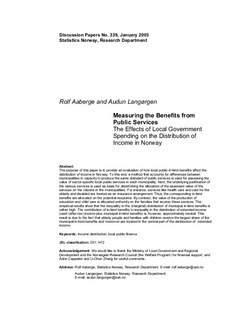Measuring the benefits from public services : the effects of local government spending on the distribution of income in Norway
Working paper

Åpne
Permanent lenke
http://hdl.handle.net/11250/180459Utgivelsesdato
2003Metadata
Vis full innførselSamlinger
- Discussion Papers [1002]
Sammendrag
Abstract:
The purpose of this paper is to provide an evaluation of how local public in-kind benefits affect the distribution of income in Norway. To this end, a method that accounts for differences between municipalities in capacity to produce the same standard of public services is used for assessing the value of sector-specific local public services in each municipality. Next, the underlying justification of the various services is used as basis for determining the allocation of the assessed value of the services on the citizens in the municipalities. For instance, services like health care and care for the elderly and disabled are treated as an insurance arrangement. Thus, the corresponding in-kind benefits are allocated on the potential recipients. By contrast, the value of the production of education and child care is allocated uniformly on the families that receive these services. The empirical results show that the inequality in the (marginal) distribution of municipal in-kind benefits is rather high. The contribution of in-kind benefits to inequality in the distribution of extended income (cash (after-tax) income plus municipal in-kind benefits) is, however, approximately neutral. This result is due to the fact that elderly people and families with children receive the largest share of the municipal in-kind benefits and moreover are located in the central part of the distribution of extended income.